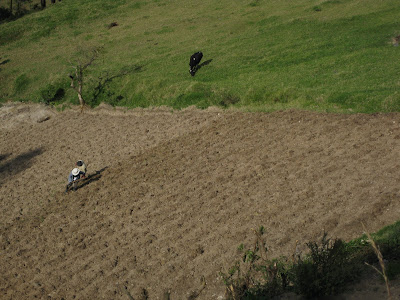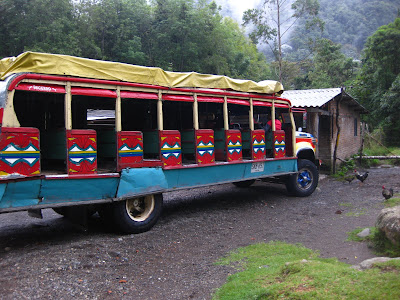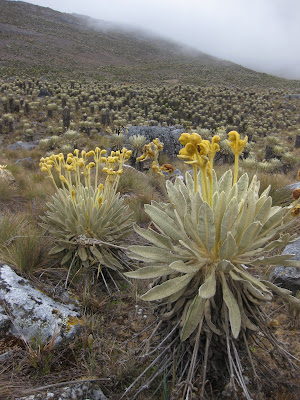
Cartagena de Indias, on Colombia's Caribbean coast, is a beautiful, historic port city. It's also run-down, filthy and full of people trying to sell cocaine to tourists. In other words, it's an authentic tropical conurbation, not a sanitized tourist town. I've wanted to visit Cartagena ever since reading James Michener's Caribbean, which contains at least one chapter dedicated to what was once Spain's most important New World seaport. Founded by the Spanish in 1533, Cartagena grew into a walled city protecting a fantastic natural harbor. For hundreds of years, as the conquistadors subdued and "developed" the South American interior (the conquest and plunder of the Incan Empire but one example), the city served as the gateway to the Spanish colonies. Shiploads of African slaves were unloaded as galleons full of gold sailed for Europe. The arrival of these treasure ships often depended on their ability to evade or outfight the English, Dutch and French privateers prowling the Caribbean.
Today in Cartagena, palms still toss their fronds above the old city walls, while obsolete cannon litter the cobbled squares. Despite a hundred-year run of hard luck, much of the historic city has been restored, and Cartagena claims a proud (and economically crucial) place on the Caribbean cruise circuit. Inevitably, the tourist veneer has worn thin in places, and sometimes only a block separates serene plazas full of pigeons and cafés from the gritty hustle of real life. It's the kind of duality I love and live, working in tourism and traveling for a living. Everyone complains about how touristy everything's become, but walk a few blacks away from the main square and there you are: eating the daily special in a crowded hole-in-the-wall instead of paying for a view and a bad chef salad. The historic center is an alluring mix of cobbled streets, tree-filled plazas, colonial architecture and balconies dripping flowers into the lanes below. I spent many hours wandering, absorbing, reading the paper and slurping down fresh juices. It's easy to understand why Cartagena is one of the crown jewels of the Caribbean, with so many layers to explore, and so much beauty and history to offer.
Staying outside the city walls in the aging neighborhood of Getsemaní offered up a different side of the city. A gushing guidebook author might describe this barrio in terms of "faded splendor", but I'm afraid that even down-at-heel would be generous. It's a total sh##hole. The colonial blocks of yesteryear are crumbling, unchecked, into the dirty streets, where taxis careen madly between the echoed cries of coffee-sellers. I hadn't been there ten minutes before a ragged old gentleman short on teeth but long on eloquence introduced himself to me as The Boss. Laying a conspiratorial hand on my shoulder and lowering his voice, he laid it all out. "Whatever you want, I can get it. This is my street: they all know me." He gestured toward other dealers lurking in broad daylight between piles of rubbish and the doorways of cheap hotels. "Anything, the best coke, hookers, just tell me. I'm the boss." I let him know with a firm friendliness that he would definitely be my first choice, then beat it back into my guesthouse. I ended up having a great time in Cartagena. Between the mellow old town vibe and the coarse pleasures of the living city, there was no lack of diversion:
Plaza Santo Domingo, 2:30 in the afternoon. Framing a steeple in my view-finder, I saw them coming out of the corner of my eye. Two friendly, twentysomething locals? Or two dudes with a scam? I had the time and decided to find out. What would it be - the tour guide pitch, a hotel, a tour company? Here's how it went down:
Hello, my friend, how are you? Where you from? Boston I lied. (It saves a five minute geography lesson on Vermont.)
Great! I love Boston, I have many friends there.
Yeah, it's a great city, lots to do. What are you guys up to?
Nothing, man, nothing. Listen, there's a party later. It's at the Banana Bar, you want to come? It's for the university. There's going to be lots of girls there. A lot. You like girls? It's going to be crazy!
OK, party promoters. Hadn't expected that.
Of course I like girls I said. You know Snoop Dogg? They looked at each other. Yeah! Snoop Dogg - a rapper. We know Snoop Dogg.
He does a show called Girls Gone Wild. You guys should check it out.
Yeah! Snoop Dogg!
OK. We talked about Snoop Dogg and the Banana Bar. Were could it go from there? Suddenly, the lean-in.
Listen, amigo, this is Colombia, we have the best shit. You want some? The best coke man. . .
Here? Now? In the square? All I could do was laugh, and suddenly I had a great idea to turn the tables.
I don't take drugs, amigo, but thanks. Can I talk to you guys about something? A flicker of doubt as they glanced at each other. I don't take drugs because I'm a Mormon. I'm a member of the Mormon church, and I really want to tell you about it.
Faltering smiles and a few steps back. I close the gap by walking towards them and reaching into my bag.
Have you heard of the Book of Mormon? I have one right here I want to show you. . . Are you a friend of Christ?
Retreat! Retreat! They were falling over themselves to get away.
Thanks, but we're busy, very busy. See you later! I followed for a few steps, just for the effect.
I want to help you!
Today in Cartagena, palms still toss their fronds above the old city walls, while obsolete cannon litter the cobbled squares. Despite a hundred-year run of hard luck, much of the historic city has been restored, and Cartagena claims a proud (and economically crucial) place on the Caribbean cruise circuit. Inevitably, the tourist veneer has worn thin in places, and sometimes only a block separates serene plazas full of pigeons and cafés from the gritty hustle of real life. It's the kind of duality I love and live, working in tourism and traveling for a living. Everyone complains about how touristy everything's become, but walk a few blacks away from the main square and there you are: eating the daily special in a crowded hole-in-the-wall instead of paying for a view and a bad chef salad. The historic center is an alluring mix of cobbled streets, tree-filled plazas, colonial architecture and balconies dripping flowers into the lanes below. I spent many hours wandering, absorbing, reading the paper and slurping down fresh juices. It's easy to understand why Cartagena is one of the crown jewels of the Caribbean, with so many layers to explore, and so much beauty and history to offer.
Staying outside the city walls in the aging neighborhood of Getsemaní offered up a different side of the city. A gushing guidebook author might describe this barrio in terms of "faded splendor", but I'm afraid that even down-at-heel would be generous. It's a total sh##hole. The colonial blocks of yesteryear are crumbling, unchecked, into the dirty streets, where taxis careen madly between the echoed cries of coffee-sellers. I hadn't been there ten minutes before a ragged old gentleman short on teeth but long on eloquence introduced himself to me as The Boss. Laying a conspiratorial hand on my shoulder and lowering his voice, he laid it all out. "Whatever you want, I can get it. This is my street: they all know me." He gestured toward other dealers lurking in broad daylight between piles of rubbish and the doorways of cheap hotels. "Anything, the best coke, hookers, just tell me. I'm the boss." I let him know with a firm friendliness that he would definitely be my first choice, then beat it back into my guesthouse. I ended up having a great time in Cartagena. Between the mellow old town vibe and the coarse pleasures of the living city, there was no lack of diversion:
Plaza Santo Domingo, 2:30 in the afternoon. Framing a steeple in my view-finder, I saw them coming out of the corner of my eye. Two friendly, twentysomething locals? Or two dudes with a scam? I had the time and decided to find out. What would it be - the tour guide pitch, a hotel, a tour company? Here's how it went down:
Hello, my friend, how are you? Where you from? Boston I lied. (It saves a five minute geography lesson on Vermont.)
Great! I love Boston, I have many friends there.
Yeah, it's a great city, lots to do. What are you guys up to?
Nothing, man, nothing. Listen, there's a party later. It's at the Banana Bar, you want to come? It's for the university. There's going to be lots of girls there. A lot. You like girls? It's going to be crazy!
OK, party promoters. Hadn't expected that.
Of course I like girls I said. You know Snoop Dogg? They looked at each other. Yeah! Snoop Dogg - a rapper. We know Snoop Dogg.
He does a show called Girls Gone Wild. You guys should check it out.
Yeah! Snoop Dogg!
OK. We talked about Snoop Dogg and the Banana Bar. Were could it go from there? Suddenly, the lean-in.
Listen, amigo, this is Colombia, we have the best shit. You want some? The best coke man. . .
Here? Now? In the square? All I could do was laugh, and suddenly I had a great idea to turn the tables.
I don't take drugs, amigo, but thanks. Can I talk to you guys about something? A flicker of doubt as they glanced at each other. I don't take drugs because I'm a Mormon. I'm a member of the Mormon church, and I really want to tell you about it.
Faltering smiles and a few steps back. I close the gap by walking towards them and reaching into my bag.
Have you heard of the Book of Mormon? I have one right here I want to show you. . . Are you a friend of Christ?
Retreat! Retreat! They were falling over themselves to get away.
Thanks, but we're busy, very busy. See you later! I followed for a few steps, just for the effect.
I want to help you!
Obviously they knew just enough to be scared, but their fear blinded them. I wasn't wearing slacks, a short-sleeved button-up or a name tag, and I wasn't tag teaming. But they still ran. . .


































 Wondering how much further at 14,000
Wondering how much further at 14,000 The Pyramid dwarfs our tent at Laguna de la Plaza
The Pyramid dwarfs our tent at Laguna de la Plaza



